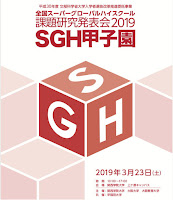2019年3月23日土曜日に 関西学院大学 西宮上ヶ原キャンパスで「全国スーパーグローバルハイスクール課題研究発表会 2019【SGH甲子園】」( 主催 関西学院大学/大阪大学/大阪教育大学)が行われました。
本校からは、2年生の森吉天さん、田中理歩さんが研究成果ポスタープレゼンテーション部門にエントリーし、1年間『探究』の授業で取り組んだ研究の成果を英語で発表しました。
発表タイトルは、Which Dress Would You Buy? ~Actions Taken for the Abolition of Child Labor in India and Cambodia~。アパレル産業における児童労働をなくすためにインドとカンボジアにおいてこれまでに行われた対策を調べ、今後日本で必要とされる対策について考察しました。
参加数はこの大会で最大の109校150チーム。このうち、英語による研究成果ポスタープレゼンテーション部門には31校がエントリーしていました。この中で、本校生2人による発表は、最優秀賞に次ぐ「優秀賞」を受賞しました。
■発表原稿
Which dress would you buy and how would you choose?
■体験記
・「SGH甲子園2017 日本語プレゼンテーションの部で最優秀賞」の記事はこちらから
 |
| 開会式の様子 |
本校からは、2年生の森吉天さん、田中理歩さんが研究成果ポスタープレゼンテーション部門にエントリーし、1年間『探究』の授業で取り組んだ研究の成果を英語で発表しました。
発表タイトルは、Which Dress Would You Buy? ~Actions Taken for the Abolition of Child Labor in India and Cambodia~。アパレル産業における児童労働をなくすためにインドとカンボジアにおいてこれまでに行われた対策を調べ、今後日本で必要とされる対策について考察しました。
 |
| 発表で使用したポスター(クリックで拡大表示) |
参加数はこの大会で最大の109校150チーム。このうち、英語による研究成果ポスタープレゼンテーション部門には31校がエントリーしていました。この中で、本校生2人による発表は、最優秀賞に次ぐ「優秀賞」を受賞しました。
■発表原稿
Which dress would you buy and how would you choose?
> Which dress would you buy? And why? As you can see, these two dresses look similar, but the prices are different. One of the factors behind this is that one of these was made by children. According to this book, lots of fast fashion is based on child labor. This is a problem happening even in Japan, so we have to be more responsible. But how? As of 2016, 64 million girls and 88 million boys, about one in ten children in the world are under child labor. Over 40% of the world’s child labor population is in Asia. One of the sectors they work in is the apparel industry.
> From our research, we have found that Cambodia, India, and America have taken action to solve this problem.
> Human Rights Watch interviewed workers in Cambodia’s garment factories and found the use of child labor in at least 11 factories. Workers including children reported that they were working long hours and children reported that they were paid less than the minimum wage and weren’t able to go to school. In the interview many children said that they are working because their families are poor. For this reason, the reality was that Cambodia couldn’t ban child labour easily. In response to this, BFC an ILO’s programs aim to improve working conditions in Cambodia’s export garment factories and GMAC signed an agreement that workers under 15 years old will be given access to vocational training institutes and be paid the average wage of factory workers in Cambodia.
> In July 2010, the US Department of Labor published a report on what goods are made by children. This report includes facts on products from the apparel industry. In November that year, the apparel industry of India reached an agreement with the US Department of Labor. They accepted advice about reducing child labor and developing guidelines on labor practices. Also, the US government has made an action to stop child labor. In 2016, the former US president Obama revised a law concerning child labor. The new law says that they will not import products made by children under any conditions.
> But these are solutions taken in other countries. What do people in Japan need to do to reduce child labor? Here are some solutions.
First, the government should make rules or laws to reduce the import of garments made by children just like Obama did in the US. If we stop importing garments made by children, the manufacturers will have to stop using children to make their products to maintain their sales. Some of you may think that they should ban the import of garments made by children, but in reality, children can’t help but work so we should consider this more carefully and think of the best solutions for each country.
> As consumers, we need to look for garments that aren’t made by children.
To support this, the Apparel industry or NGOs should make some marks that will help us to identify if the product is made by children or not. In the present situation, there are brands like Patagonia that prints fair trade labels on products but we don’t usually see such marks on clothing tags and marks like RUGMARK which tell us that the rug wasn’t made by children. If we see such marks on clothing tags, we can make better choices about the products we buy. Also, because we feel that Japanese people’s awareness about child labor is very low, to create more awareness about it.
> Now that you’ve listened to our presentation, look at these dresses once again, which dress would you buy? and how would you choose?
■体験記
>今回のSGH甲子園では、12月のSGH全国高校生フォーラムで学んだことをプレゼンに取り入れ、納得のいく結論まで作り、前日にはALTや社会科の先生方に発表を聞いてもらいアドバイスをもらうことで自信を持って発表することができました。発表後に受けた質問にも、3か月探究を進め問題を理解することで、周りを納得させられるような答えができました。2回目の全国レベルのプレゼンだったこともあり、12月より落ち着いて発表することができました。結果ポスタープレゼンの英語部門で優秀賞を頂くことができ、1年の努力が報われて嬉しかったです。閉会式の後のエキシビジョンとして行われた優秀賞の日本語プレゼンは同じ高校生とは思えないほど自分で実験と考察を繰り返しており、参考になりました。
>私たちが今回取り上げたのは、児童労働という、私たちにとって一見関係のないように思えてしまう問題です。ただ世界のどこか遠くで起こっている問題程度でスルーされてしまうことが多く、探究をする前の私もスルーしてしまう人のうちの1人でしたでした。今回のプレゼンでは児童労働について1人でも多くの人に知ってもらいたいと、注目の引くタイトルにするなど工夫をしました。私たち高校生にできることはそれほど多くありませんが、今回のように世界の問題をプレゼンという形で周りに共有することだけでも大きな行動の一つだと感じました。将来大学で社会学を専攻し、現代社会にある問題について、原因やお互いに与える影響などをもっと深く学びたいとこの探究を通じて強く思うようになりました。
>これから探究を進める後輩の皆さんへ: 私がこのテーマにたどり着いたのは幼い頃の疑問が元になっています。母親が安価な服を買わなかっため、安い服には何があるんだろう?と疑問に感じていました。そこでファストファッションの裏側について調べてみて、児童労働という問題を知りました。探究はすごく難しそうに感じるかもしれないし、探究したいテーマがなかなか見つからないかもしれないですが、幼い頃からの疑問や今自分の中にある疑問を調べてみたら、自分にとっても楽しいやりがいのある探究になると思います。12月のSGH全国高校生フォーラムや今回のSGH甲子園にもぜひ積極的に参加してほしいです。
---------------------------------------------------------------------------------------------------------------
・「SGH甲子園2018 出場者から後輩へのメッセージ」の記事はこちらから・「SGH甲子園2017 日本語プレゼンテーションの部で最優秀賞」の記事はこちらから





